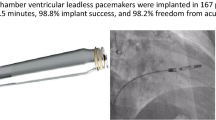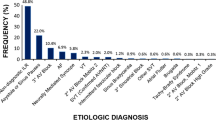Abstract
The objective of this study was to assess the effects ofradiofrequency energy application on implanted pacemaker functions.Radiofrequency (RF) catheter ablation may cause pacemaker dysfunction dueto electromagnetic interferences. The effects of RF on pacemaker behaviorwere studied in a series of 38 pacemakers, implanted 18 ± 26 monthsprior to a RF procedure using either a right ventricular approach (AV nodeablation, n = 35) or a left ventricular approach (left concealedaccessory pathway ablation, n = 1; VT ablation, n = 2). The38 patients (mean age 65 ± 9 years) included 20 men and 18 women.Before energy applications, the 23 different pacemaker models wereprogrammed to the VVI mode at the lowest available rate. The continuoussurface ECG was recorded throughout the procedure. Thorough testing of thedevices was performed before and after each RF delivery. Unusual pacemakerresponses occurred in 20 of the 38 cases studied (53%). The impactof RF delivery was unpredictable, and variable dysfunctions were observedat different times for a given patient or could vary for a given model.Unusual pacemaker responses included pacemaker inhibition (n = 8), untoggled backup mode (n = 3), electromagnetic interference noisemode (n = 3), temporary RF-induced pacemaker tachycardia (n =2), erratic behavior (n = 1), oversensing of RF onset and offset (n= 8), and transient loss of ventricular capture, (n = 1).Postablation, most devices automatically toggled back to fullfunctionality. The three devices in the untoggled backup mode had to bereprogrammed to obtain normal operations. At the end of the procedure,pacing thresholds remained unchanged in all but one patient, in whom theincrease in ventricular threshold was due to a nicked lead. In conclusion,implanted pacemakers frequently exhibit transient, unpredictable responsesto RF energy application. Although all pacemaker functions were restored postablation, some devices had to be reset manually. The anomalies observedduring the RF application argue for the simultaneous use of an externalpacemaker in pacing-dependent patients.
Similar content being viewed by others
References
Jackman WM, Wang X, Friday KJ, et al. Catheter ablation of accessory atrioventricular pathways (Wolff-Parkinson-White syndrome) by radiofrequency current. N Eng J Med 1991;324:1605–1611.
Landberg JJ, Chin MC, Rosenquist M, et al. Catheter ablation of the atrioventricular junction with radiofrequency energy. Circulation 1989;80:1527–1535.
Lesh MD, Van Hare GF, Epstein LM, et al. Radiofrequency catheter ablation of atrial arrhythmias: Results and mechanisms. Circulation 1994;89:1074–1089.
Klein LS, Shih HT, Hackett FK, et al. Radiofrequency catheter ablation of ventricular tachycardia in patients without structural heart disease. Circulation 1992;85:1666–1674.
Marco D, Eisinger G, Hayes DL. Testing of work environments for electromagnetic interference. PACE 1992;15: 2016–2022.
Ellenbogen KA, Wood MA. Cellular telephones and pacemakers: Urgent call or wrong number? Am Coll Cardiol 1996;27:1478–1479.
Chang AC, McAreavey D, Tripodi D, et al. Radiofrequency catheter atrioventricular node ablation in patients with permanent cardiac pacing systems. PACE 1994;17:65–69.
Ellenbogen KA, Wood MA, Stambler BS, et al. Acute effects of radiofrequency ablation of atrial arrhythmias on implanted permanent pacing systems. PACE 1996;19: 1287–1295.
Pfeiffer D, Tebbenjohanns J, Schumacher B, et al. Pacemaker function during radiofrequency ablation. PACE 1995;18:1037–1044.
Chin MC, Rosenqvist M, Lee MA, et al. The effect of radiofrequency catheter ablation on permanent pacemakers: An experimental study. PACE 1990;13:23–29.
Toivonen L, Valjus J, Hongisto M, Mesto R. The influence of elevated 50 Hz electric and magnetic fields on implanted cardiac pacemakers: The role of the lead configuration and programming on the sensitivity. PACE 1991;14:2114–2122.
Barold SS, Falkoff MD, Ong LS, et al. Interference in cardiac pacemakers; Exogenous sources. In: N El Sherif, P Samet, Cardiac Pacing and Electrophysiology, 3rd ed. Philadelphia: WB Saunders, 1991:608–632.
Strathmore N. Interference in cardiac pacemakers. In: KA Ellenbogen, GN Kay, BL Wilkoff, eds. Clinical Cardiac Pacing. Philadelphia: WB Saunders, 1994:770–779.
Telectronics Technical Manual. Meta 1254 DDDR. Englewood, CO: Telectronics, Inc.
Author information
Authors and Affiliations
Rights and permissions
About this article
Cite this article
Sadoul, N., Blankoff, I., de Chillou, C. et al. Effects of Radiofrequency Catheter Ablation on Patients with Permanent Pacemakers. J Interv Card Electrophysiol 1, 227–233 (1997). https://doi.org/10.1023/A:1009721023732
Issue Date:
DOI: https://doi.org/10.1023/A:1009721023732




